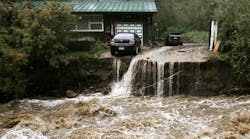My wife Charla and I moved to Colorado about 11 years ago. We had lived in the San Francisco Bay Area for decades. But now the kids were out of the house, I was offered a job in beautiful Boulder and off we went. I was on business travel right away so Char spent a lot of time with the real estate agent looking at potential homes. She was looking at what I thought were pretty ho-hum neighborhoods – near shopping and highway access. But what I wanted was a rustic large cabin in the midst of trees with a deck hanging over a creek loaded with cutthroat trout.
The huge forest fires over the last several years were an eye opener. Forget living in the forest. And this last week reminded me how much I ridiculed her for insisting that we carefully avoid potential flood zones. Ha – I laughed. You gotta do that in the low lands maybe. But here in Colorado? Gimme a break.
I regularly thank God that Char won out and we did okay during possibly the biggest flood in Colorado history (now being called a 1,000 year flood). We don't know how high some of the rivers and streams crested because the gauges were washed away. But all around us is destruction.
Here's the National Center For Atmospheric Research (NCAR) take on what happened and why: Colorado Deluge
The Boulder old time music jam that I regularly attend, one of the oldest anywhere, had its first cancellation in 30 years because the house where it's always been held was near Boulder Creek and flooded.
The little mountain town of Lyons where we stop at our favorite coffee shop on our way to Rocky Mountain National Park is obliterated. Lyons is also home of the 40 year-old Rockygrass annual bluegrass festival. The Rockygrass area is completely underwater. Two thousand Lyons residents huddled without power or much shelter until National Guard started getting them out by helicopter. Lyons is just one of many stranded mountain communities without power or phone service. I live near a major trauma center and we hear helicopters landing off and on all day.
We didn't have much wind so there's isn't that type of structural damage to power lines. And we don't have a lot of underground vaults and cable so we didn't have the power chaos of the eastern storms. In the mountains the power was just out and that was that.
Estes Park, one of Colorado's biggest tourist cities, was flooded and cut off. The only exit was to go west, over the Continental Divide (12,000 feet) into western Colorado. And now that's cut off.
And on it goes – as of this writing about 20,000 homes damaged or destroyed (most, I'm sure, without flood insurance). The death toll will no doubt rise.
Some grim humor though. Apparently some guy and his dog in Boulder got washed into a street drain, traveled two blocks underground and got blown out into a creek. Man and dog are ok.
Our power went out for a few hours. A neighbor called Xcel and was told it would be fixed in 3 hours, 14 minutes (odd number). It came back on in 3 hours, 1 minute by my watch. We had dinner by candlelight that night. Fortunately we have a gas stove top so we took big pots with water in the bottom and steamed leftovers. We could charge our phones with the cars so we could communicate with neighbors
and get emergency info. We were all set for days without power, if need be.
There are so many unknowns right now. Hundreds of folks are missing. Hopefully most are just stuck in mountain communities without communication. There's no definite count of power outages except in larger areas. Colorado is sparsely settled (about 5.5 million) with a number of small coop utilities so facts and figures are hard to get.
I'm wondering if this experience will have any impact on Boulder's decision to kick out Xcel and municipalize. It will be interesting to see how the infamous Xcel Smart Grid City technology held up.
So now the rain seems to be going away (I think) and we expect to start drying out. Our cell phones no longer buzz as frequently with flash flood alarms. But our community's protective numbness will wear off and the thinking and wondering and, for some, fear and despondency will set in.
Still, as the rain clouds lift I can almost see the mountain peaks to the west. Apparently we got some snow above 11,000 feet. Fall is coming, with all the beautiful Colorado trimmings. Along with the majority of these hardy, native Coloradans, we wouldn't want to live anywhere else.


